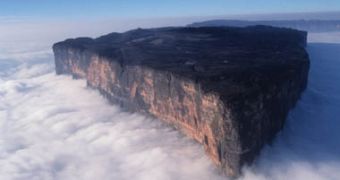The name Tepui ("house of gods") comes from the language of the Pemon Indians and refers to the table-top mountain encountered only in the Guayana highlands of northern South America.
Tepuis are isolated mountains, rising abruptly from the rain forest or savanna, and not forming chains, things that makes them have of a unique variety of endemic plant and animal species. Angel Falls, the world's tallest waterfall, originates in a tepui.
Mount Roraima is the highest and most famous of the tepuis. It is found at the border between Venezuela, Brazil and Guyana (80% in Venezuela). It is the highest peak in Guyana, and it is located at 5?12'08N, 60?44'07W. Its highest point is at 2,810 m (8986 ft).
The plateau of Roraima has 50 square km (20 square mi), a real natural labyrinth made of canyons and amphitheaters. The soil of the tepui is made mainly of quartzite, a tough, compact grindstone, deposed 1.7 billion years ago, in Precambrian, being one of the Earth's oldest rocks. Along the years, water dissolved sand particles, modeling stone blocks, like ruined castles or small towers blackened by likens.
The Guyana shield has never been covered by waters. In the tepui, plants and animals had to adapt to extreme conditions and unfertile soil. During the rainy season, between January to March, large amounts of rainfall strip the rocks, increasing the volume of the waters of the Orinoco River.
Even if placed in Equator, the temperature is relatively cold, with an annual average value of only 8 degrees C. Because of the poor soil, some plants are carnivorous, getting the required nitrogen and phosphorus this way. Many grow on a very acid pit.
Generally, the tepui have an endemic array of species adapted to these conditions. During the Ice Ages, the tepui vegetation descended to the base of the tepui, while during the warm interglacial ascended back on the top of the tepui. The most typical flowers of the tepui are the yellow Stegolepis.
In the caves of the tepui nests the Oilbird (Steatornis caripensis), also called gu?charo, the only bird known to use echolocation (like bats), only that they do not use ultrasounds, but audible sounds. The tepui have a fauna of 1 m (3.3 ft) long earthworms, frog-eating shrews and caecilians (limbless worm-resembling amphibians). Caecilians are blind and use their large teeth for consuming insect larvae.
The Pemon Indians live at the base of Roraima, in the Gran Sabana. The population of 12,000 lives from farming, hunting and little cattle raising, but also from tourism, being carriers and guides for those intending to discover Roraima.
Arthur Conan Doyle was inspired for his "The Lost World" by Roraima to place his world of Iguanodons and pterosaurs.

 14 DAY TRIAL //
14 DAY TRIAL //